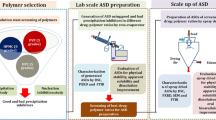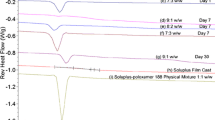Abstract
An amorphous phase produced by micronization up to the molecular or colloidal level of a poorly soluble drug having low lipophilicity can distinctly enhance its solubility characteristics. However, though dispersing the molten mass of a poorly water-soluble drug within polymeric matrix has been found to be most effective in formation of molecular dispersions, the drug molecules which melt at high temperature also accompanied by decomposition, such as acetazolamide, are difficult to formulate as molecular dispersions. Hence, a method is proposed to obtain molecular dispersions of acetazolamide with poloxamer-237 by spray congealing under optimal heat treatment. Uniform molecular and/or colloidal dispersions of the drug were achieved with instantaneous solvent evaporation by mixing a drug solution with molten mass of the plasticizer matrix. Immobilization of dispersed drug molecules was effected subsequently through rapid solidification by spray congealing. Initial characterization of 1:1, 1:1.5, and 1:2 ratios of solid dispersions and devitrification study of an optimized (1:2) ratio ensured efficacy of the proposed method in formation of physically stabilized amorphous systems without thermal degradation and hence resulted in more than ninefold rise in solubility and more than 90% dissolution within initial 10 min. With 1:2 ratio, molecular dispersions could be achieved by initial solvent evaporation stage, which when subjected to spray congealing produced physically stable amorphous systems, without signs of thermal degradation. This study also proposes an opportunity for selection of those polymers with which the drug is immiscible in their fluid state, yet obtaining molecular dispersions.






Similar content being viewed by others
References
Myrdal P, Jozwiakowski M. Alteration of the solid state of the drug substances: polymorphs, solvates and amorphous forms. In: Liu R, editor. Water-insoluble drug formulation. New York: CRC; 2008. p. 531–66.
Hancock B. Amorphous pharmaceutical systems. In: Swarbrick J, editors. Encyclopedia of pharmaceutical technology. USA. Informa Healthcare USA Inc; 2007. p. 83–91.
Hilden LR, Morris KR. Physics of amorphous solids. J Pharm Sci. 2004;93:3–12.
Ambike AA, Mahadik KR, Paradkar AR. Stability study of amorphous valdecoxib. Int J Pharm. 2004;282:151–62.
Kulthe VV, Chaudhari PD. Stabilisation of amorphous form of poorly water-soluble drug and hence solubility enhancement using poloxamer-188 and gelucire-50/13. Ind Drugs. 2011;48:25–37.
Shamma RN, Basha M. Soluplus®: A novel polymeric solubiliser for optimization of carvedilol solid dispersions: Formulation design and effect of method of preparation. Powder Technol. 2013;237:406–16.
Elgindy N, Elkhodairy K, Molokhia A, et al. Lyophilisation monophase solution technique for improvement of the physicochemical properties of an anticancer drug. Flutamide Eur J Pharm Biopharm. 2010;74:397–405.
Sarode AL, Sandhu H, Shah N, et al. Hot melt extrusion (HME) for amorphous solid dispersions: predictive tools for processing and impact of drug polymer interactions on supersaturation. Eur J Pharm Biopharm. 2013;48:371–84.
Yunzhe S, Rai Y, Wenliang Z, et al. Nimodipine semi-solid capsules containing solid dispersions for improving dissolution. Int J Pharm. 2008;359:144–9.
Tong HHY, Du Z, Wang GN, et al. Spray freeze drying with polyvinylpyrrolidone and sodium caprate for improved dissolution and oral bioavailability of oleanic acid, a BCS class IV compound. Int J Pharm. 2011;404:148–58.
Fini A, Rodriguez L, Cavallari C, et al. Ultrasound compacted and spray congealed indomethacin/polyethylene glycol systems. Int J Pharm. 2002;247:11–22.
Yajima T, Itai S, Takeachi H, et al. Optimum heat treatment conditions for masking the bitterness of the clarithromycin wax matrix. Chem Pharm Bull. 2003;51:1223–6.
Gabbott P. A practical introduction to differential scanning calorimetry. In: Gabbott P, editor. Principle and applications of thermal analysis. UK: Blackwell Publishing Ltd; 2008. p. 1–50.
Brittain HG. Analytical profiles of drug substances and excipients. 22nd ed. San Diego: Academic; 1993.
Burnham L, Dollimore D, Alexander KS. Kinetic study of the drug acetazolamide using thermogravimetry. Thermochim Acta. 2001;392:127–33.
Sichina WJ. DSC as problem solving tool: measurement of percent crystallinity of thermoplastics [application note]; 2012. Available from: http://www.perkinelmer.com/Content/applicationnotes/app_thermalcrystallinitythermoplastics.pdf
Pradhan DK, Chaudhary RNP, Samantharay BK, et al. Effect of plasticizer on structural and electrical properties of polymer nanocomposite electrolytes. Eur J Pharm Biopharm. 2009;73:162–71.
Boutonette-Fagegaltier N, Lamure A, Menegotto J. The use of thermally stimulated current spectroscopy in the pharmaceutical sciences. In: Craig DQM, Reading M, editors. Thermal analysis of pharmaceuticals. New York: CRC; 2007. p. 359–82.
Kulthe VV, Chaudhari PD, Chakraborty S. Utility of plasticized polymer in solid dispersions for solubility enhancement of thermosensitive and poorly soluble API. J Pharm Res. 2013;6:515–21.
Widjaja E, Kanujia P, Lau G, et al. Detection of trace crystallinity in an amorphous system using Raman microscopy and chemometric analysis. Eur J Pharm Sci. 2011;42:45–54.
Author information
Authors and Affiliations
Corresponding author
Rights and permissions
About this article
Cite this article
Kulthe, V.V., Chaudhari, P.D. Effectiveness of Spray Congealing to Obtain Physically Stabilized Amorphous Dispersions of a Poorly Soluble Thermosensitive API. AAPS PharmSciTech 15, 1370–1377 (2014). https://doi.org/10.1208/s12249-014-0164-1
Received:
Accepted:
Published:
Issue Date:
DOI: https://doi.org/10.1208/s12249-014-0164-1




